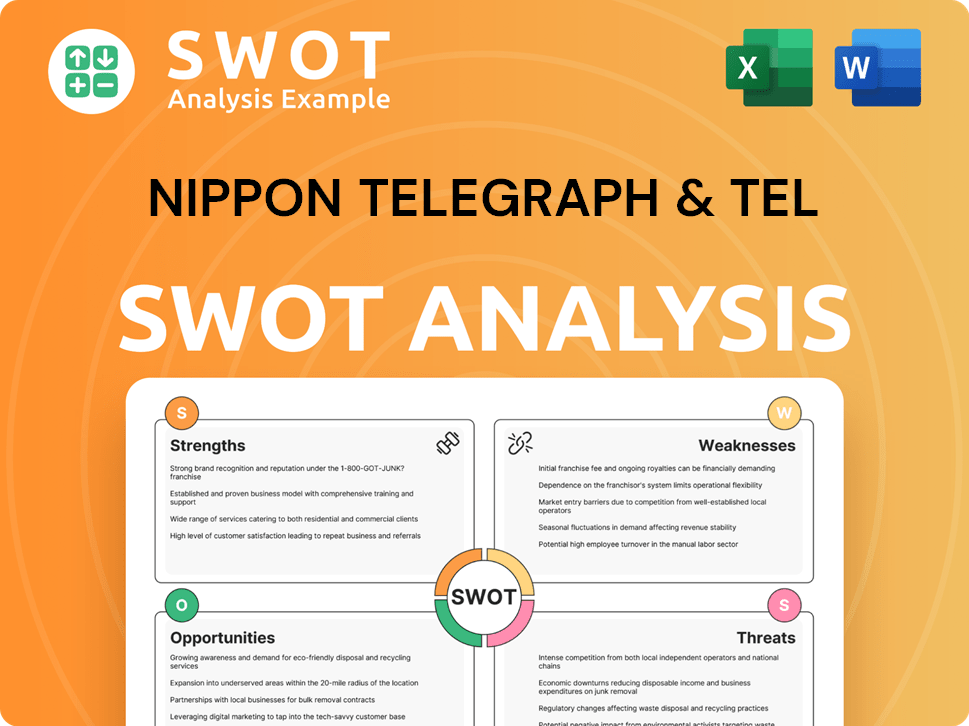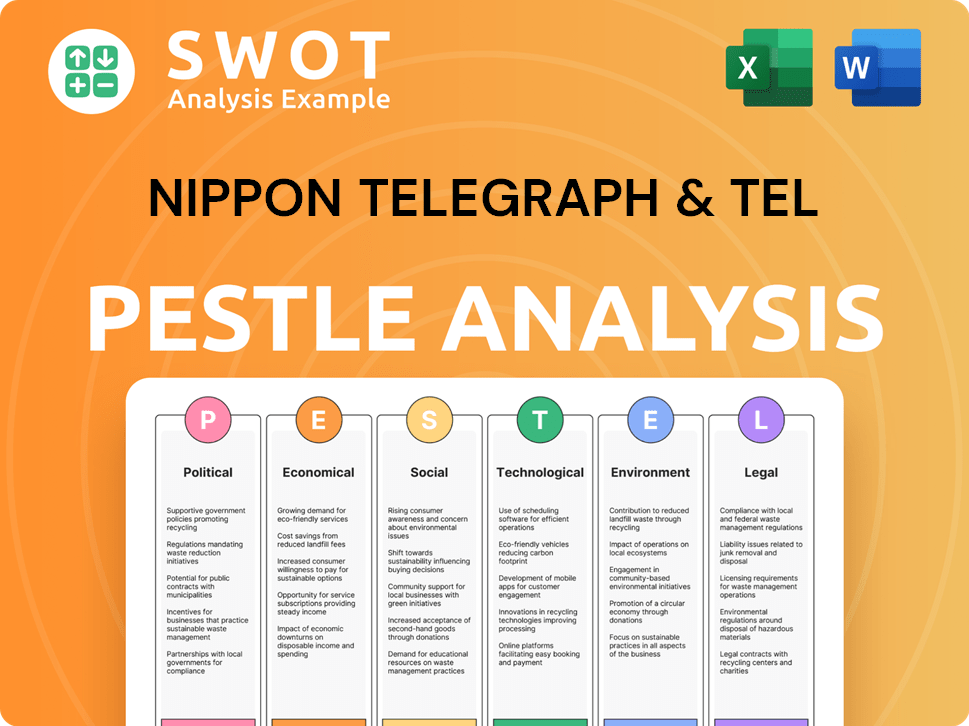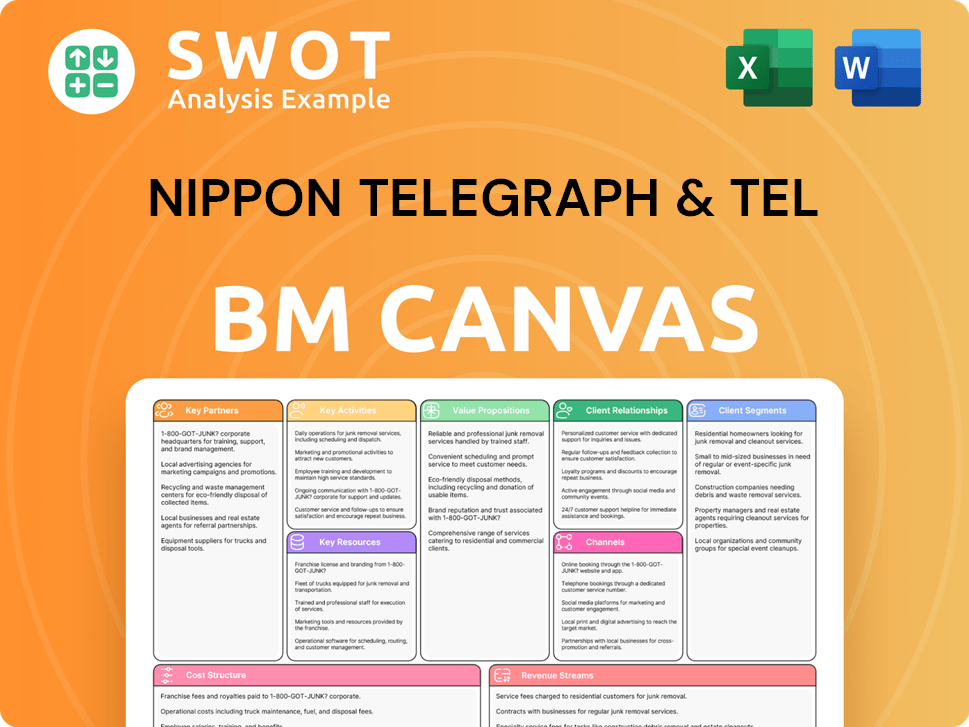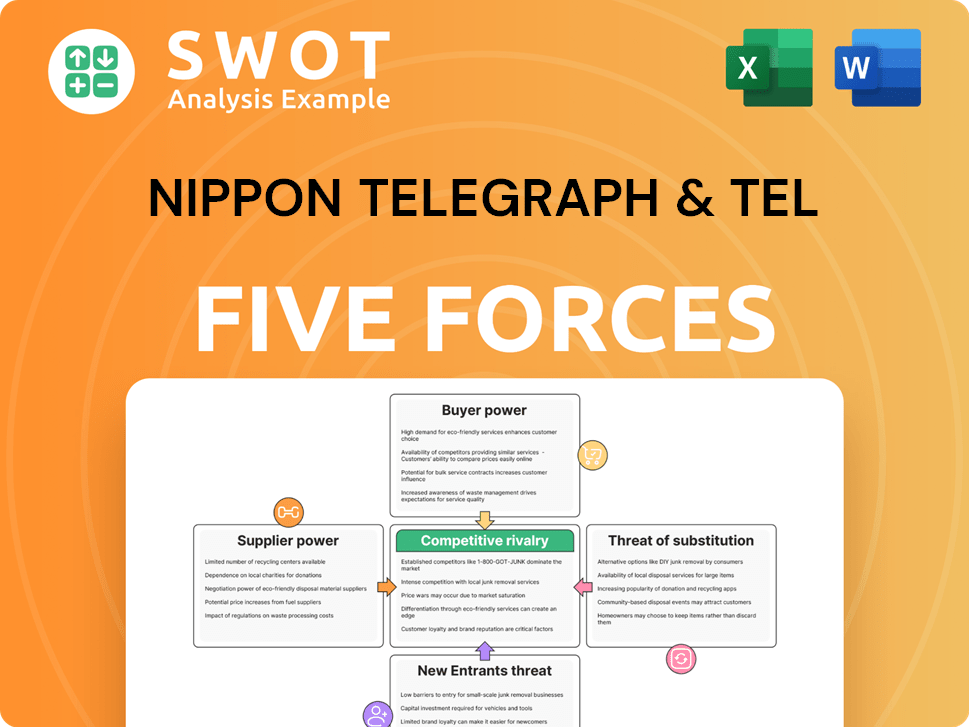Nippon Telegraph & Tel Bundle
Who Really Owns Nippon Telegraph & Telephone?
Unraveling the ownership of Nippon Telegraph and Telephone (NTT) is key to understanding its global influence and strategic direction. From its roots as a government-owned entity to its current status, NTT's ownership structure has undergone a fascinating transformation. This exploration will illuminate the key players that shape this telecommunications giant.

NTT's journey began with a vision to connect Japan, evolving into a global powerhouse. The Japanese government's role remains significant, even after privatization in 1985. Understanding Nippon Telegraph & Tel SWOT Analysis is crucial for investors and strategists alike, as it offers insights into the company's strengths, weaknesses, opportunities, and threats, all shaped by its unique ownership dynamics and the ongoing influence of the NTT Group.
Who Founded Nippon Telegraph & Tel?
The story of Nippon Telegraph & Telephone (NTT) begins with its roots firmly planted in government control. Unlike many companies founded by individual entrepreneurs, NTT's inception was orchestrated by the Japanese government. This governmental foundation shaped its early ownership and strategic goals.
In 1952, the Japanese government established the Nippon Telegraph and Telephone Public Corporation, also known as Denden Kosha. This entity took over the telecommunications responsibilities previously handled by the Ministry of Communications. The primary objective was to expand telephone services across Japan and develop a comprehensive nationwide network.
The initial ownership structure of NTT was straightforward: the Japanese government held 100% control. This ensured that the company prioritized public service and infrastructure development over immediate profit generation. There were no private investors or external shareholders during this initial phase, as it operated as a public corporation.
NTT's origins trace back to the Japanese government, which established the Nippon Telegraph and Telephone Public Corporation in 1952. This entity was created to manage and expand Japan's telecommunications infrastructure.
Initially, the Japanese government held complete ownership of NTT, ensuring a focus on public service. This structure allowed for the development of a nationwide telephone system.
NTT operated as a public corporation, with the government maintaining full control. This model prioritized infrastructure development over immediate financial returns.
Privatization began in 1985, but the government retained a significant stake to maintain oversight. The 'NTT Law' mandated government ownership of at least one-third of NTT's shares.
The Japanese government's enduring influence ensures that NTT's strategic direction aligns with national interests. This influence is a key aspect of NTT's history.
NTT's ownership structure has evolved, but the government's role remains significant. This evolution reflects changes in the telecommunications landscape.
The history of NTT ownership is marked by governmental control and strategic shifts. The Japanese government's influence has been crucial in shaping the company's trajectory.
- Governmental Origins: NTT was not founded by private entities but by the Japanese government.
- Public Corporation Phase: Initially, NTT operated as a public corporation with 100% government ownership.
- Privatization and Oversight: Privatization began in 1985, with the government retaining a significant stake.
- Current Ownership: The Japanese government continues to hold a substantial portion of NTT's shares.
- Strategic Influence: The government's role ensures that NTT's strategic goals align with national interests. For more insights, see Growth Strategy of Nippon Telegraph & Tel.
Nippon Telegraph & Tel SWOT Analysis
- Complete SWOT Breakdown
- Fully Customizable
- Editable in Excel & Word
- Professional Formatting
- Investor-Ready Format

How Has Nippon Telegraph & Tel’s Ownership Changed Over Time?
The transformation of Nippon Telegraph and Telephone (NTT) from a state-owned monopoly to a publicly traded entity marks a significant shift in its ownership structure. The privatization in 1985, converting the Nippon Telegraph and Telephone Public Corporation into the Nippon Telegraph and Telephone Corporation, was a pivotal moment. Subsequently, NTT's listing on the Tokyo Stock Exchange in 1987, with an initial public offering priced at 1.6 million yen, opened the door for public investment. This move was highlighted by the largest stock offering at the time, totaling US$36.8 billion.
The Japanese government's role in NTT ownership remains substantial, even after privatization. This is mandated by the NTT Law, which ensures the government maintains a significant stake. This structure provides the government with considerable influence over the company's strategic direction, ensuring the provision of stable telecommunications services across Japan. This evolution is crucial for understanding Marketing Strategy of Nippon Telegraph & Tel and its operations.
| Ownership Milestone | Date | Details |
|---|---|---|
| Privatization | 1985 | Transition from Nippon Telegraph and Telephone Public Corporation to Nippon Telegraph and Telephone Corporation. |
| Initial Public Offering | 1987 | Listed on the Tokyo Stock Exchange with an initial offering price of 1.6 million yen. |
| Government Stake | March 31, 2025 | The Minister of Finance holds 35.28% of the total shares issued. |
As of March 31, 2025, key institutional investors include The Master Trust Bank of Japan, Ltd. (Trust Account) with 11.05% and Custody Bank of Japan, Ltd. (Trust Account) with 4.51%. Toyota Motor Corporation also holds a notable stake of 2.44%. NTT has also engaged in share buybacks, repurchasing approximately 49% of its total issued shares through March 2025, totaling ¥5.7 trillion, which boosts capital efficiency and shareholder returns. These actions reflect the ongoing evolution of NTT's ownership and its commitment to enhancing shareholder value.
The ownership of Nippon Telegraph & Telephone is characterized by a mix of government and institutional investors.
- The Japanese government, through the Minister of Finance, holds a significant stake.
- Major institutional investors include The Master Trust Bank of Japan, Ltd. and Custody Bank of Japan, Ltd.
- Toyota Motor Corporation also holds a notable stake.
- NTT has repurchased approximately 49% of its total issued shares through March 2025.
Nippon Telegraph & Tel PESTLE Analysis
- Covers All 6 PESTLE Categories
- No Research Needed – Save Hours of Work
- Built by Experts, Trusted by Consultants
- Instant Download, Ready to Use
- 100% Editable, Fully Customizable

Who Sits on Nippon Telegraph & Tel’s Board?
The current board of directors of Nippon Telegraph and Telephone (NTT) operates under a governance structure influenced by its unique ownership. As of May 9, 2025, NTT has announced a transition to an Audit and Supervisory Committee system, aiming to enhance oversight of risk management, compliance, and capital allocation decisions. While specific individual board members representing major shareholders are not explicitly detailed in publicly available summaries, the Japanese government's significant ownership stake inherently grants it considerable influence over the board's composition and strategic decisions. The NTT Law requires the internal affairs and communications minister to approve the appointment of directors and decisions on business plans.
The Japanese government's influence is further cemented by its substantial ownership. This control is critical to ensuring the company aligns with national interests, especially regarding universal service obligations and national security. For more context on the company's origins and evolution, you can read a Brief History of Nippon Telegraph & Tel.
The voting structure of NTT primarily adheres to a one-share-one-vote principle for publicly traded shares. However, the government's mandatory minimum holding of more than one-third of the total issued shares, as stipulated by Article 4(1) of the Act on Nippon Telegraph and Telephone Corporation, etc., effectively gives it outsized control. This legal requirement ensures the government's ability to influence major resolutions and prevent hostile takeovers by foreign entities, as the law also stipulates measures to prevent the ratio of voting rights of foreign shareholders from exceeding one-third of the total. There have been discussions regarding the potential sale of government-held shares, but the government plans to maintain the requirement that it hold at least one-third of NTT's shares for the time being, highlighting the continued importance of its control for national security and universal service provision.
The Japanese government maintains significant influence over NTT through its substantial shareholding. This ownership structure ensures the government can influence major decisions and protect national interests.
- The government must hold at least one-third of NTT's shares.
- The government's approval is required for director appointments and business plans.
- This structure helps prevent foreign entities from gaining excessive control.
- NTT's governance is evolving to enhance oversight and management.
Nippon Telegraph & Tel Business Model Canvas
- Complete 9-Block Business Model Canvas
- Effortlessly Communicate Your Business Strategy
- Investor-Ready BMC Format
- 100% Editable and Customizable
- Clear and Structured Layout

What Recent Changes Have Shaped Nippon Telegraph & Tel’s Ownership Landscape?
In recent years, Nippon Telegraph & Telephone (NTT) has undergone significant shifts in its ownership structure and strategic direction. A key development has been NTT's efforts to streamline its operations and improve capital efficiency. For instance, in February 2025, NTT completed a share buyback program worth 200 billion yen, repurchasing approximately 1.33 billion shares, which represents 1.66% of its outstanding stock. This move aims to optimize the company's capital structure and boost shareholder returns.
A notable strategic move is NTT Group's plan to fully acquire NTT Data Group Corporation. In 2025, NTT Group decided to take full control of its global business services division by acquiring the remaining shares. This tender offer is valued at approximately ¥2.37 trillion ($16 billion) and is designed to simplify strategic and investment decisions, especially in areas like artificial intelligence. As of September 30, 2024, NTT Corporation already held 57.73% of NTT Data Group Corporation's shares. This acquisition is expected to strengthen the integration between NTT Data and other NTT entities, such as NTT Communications.
| Ownership Aspect | Details | Financial Impact/Strategic Rationale |
|---|---|---|
| Share Buyback (Feb 2025) | 200 billion yen; Repurchased ~1.33 billion shares (1.66% of outstanding) | Optimizes capital structure; Increases shareholder returns |
| NTT Data Acquisition (2025) | Tender offer valued at ~¥2.37 trillion ($16 billion) | Streamlines strategic decisions, particularly in AI; Strengthens ties between NTT entities |
| Government Stake | Maintains significant stake due to the NTT Law | Discussions about potential sale to fund defense spending; Current plans to maintain one-third ownership |
Industry trends also highlight an increasing focus on institutional ownership and corporate governance. The Japanese government, due to the NTT Law, maintains a significant stake in NTT. Discussions have emerged regarding the potential sale of government shares to fund defense spending, although current plans favor maintaining the one-third ownership requirement. Furthermore, NTT announced a structural transition to an Audit and Supervisory Committee system in March 2025, signaling a commitment to enhanced oversight and transparency. These developments underscore NTT's proactive approach to adapting its ownership and governance to a rapidly evolving global telecommunications landscape.
NTT's share buyback program in February 2025 involved repurchasing approximately 1.33 billion shares, representing 1.66% of its outstanding stock. This move was part of a broader strategy to enhance capital efficiency and increase shareholder value.
NTT Group's plan to fully acquire NTT Data Group Corporation, valued at approximately ¥2.37 trillion ($16 billion), aims to streamline decision-making, especially in areas like artificial intelligence, and integrate operations more closely.
The Japanese government maintains a significant stake in NTT due to the NTT Law. Discussions about the potential sale of government shares to fund defense spending have emerged, though current plans are to maintain the one-third ownership requirement.
NTT announced a structural transition to an Audit and Supervisory Committee system in March 2025, signaling a commitment to enhanced oversight and transparency. This is part of NTT's effort to adapt to the evolving global telecommunications landscape.
Nippon Telegraph & Tel Porter's Five Forces Analysis
- Covers All 5 Competitive Forces in Detail
- Structured for Consultants, Students, and Founders
- 100% Editable in Microsoft Word & Excel
- Instant Digital Download – Use Immediately
- Compatible with Mac & PC – Fully Unlocked

Related Blogs
- What are Mission Vision & Core Values of Nippon Telegraph & Tel Company?
- What is Competitive Landscape of Nippon Telegraph & Tel Company?
- What is Growth Strategy and Future Prospects of Nippon Telegraph & Tel Company?
- How Does Nippon Telegraph & Tel Company Work?
- What is Sales and Marketing Strategy of Nippon Telegraph & Tel Company?
- What is Brief History of Nippon Telegraph & Tel Company?
- What is Customer Demographics and Target Market of Nippon Telegraph & Tel Company?
Disclaimer
All information, articles, and product details provided on this website are for general informational and educational purposes only. We do not claim any ownership over, nor do we intend to infringe upon, any trademarks, copyrights, logos, brand names, or other intellectual property mentioned or depicted on this site. Such intellectual property remains the property of its respective owners, and any references here are made solely for identification or informational purposes, without implying any affiliation, endorsement, or partnership.
We make no representations or warranties, express or implied, regarding the accuracy, completeness, or suitability of any content or products presented. Nothing on this website should be construed as legal, tax, investment, financial, medical, or other professional advice. In addition, no part of this site—including articles or product references—constitutes a solicitation, recommendation, endorsement, advertisement, or offer to buy or sell any securities, franchises, or other financial instruments, particularly in jurisdictions where such activity would be unlawful.
All content is of a general nature and may not address the specific circumstances of any individual or entity. It is not a substitute for professional advice or services. Any actions you take based on the information provided here are strictly at your own risk. You accept full responsibility for any decisions or outcomes arising from your use of this website and agree to release us from any liability in connection with your use of, or reliance upon, the content or products found herein.